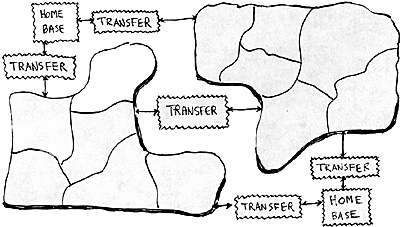At the September PW meeting, I violated my sacred oath concerning game-presentation. I had sworn, several eons ago, that I would never put on a scenario if I had to lug more than two boxes (one of figures, one for terrain) to a club meeting or convention.
Yet in September, I brought in 9-count 'em-9 boxes of 15mm Napoleonic figures and equipment. I had to admit, however, as I set up the game on the table-top, that I felt a sense, albeit a small sense, of accomplishment... my itsy-bitsy contribution to the wargaming hobby. All the stands of 15mm figures were neatly grouped around the map I had drawn, which served as a center-piece. This was what I term a "Milton Bradley" game, symbolic and strategic in nature, and designed solely to present the players with a series of decision-making events.
After the game, we discussed what should be included in a Napoleonic grand-strategy game, and my comment was to the effect that although I had used Napoleonic figures - infantry and cavalry and artillery - I could have used infantry and tanks and missiles in much the same manner for an "any era" game..
The map below displays two islands, each with 6 provinces to be conquered. Also note that troops voyaged from their home base to the islands, or between the islands, via what I called the "transfer zones". It required one turn to complete the journey, thus taking into account the time required to be at sea for the trip.
Each side was given four 15mm officers, each of whom was defined as a Corps Commander (CC). In this grand-scale game, one stand of infantry or cavalry was defined as a brigade and from 3 to 6 stands (brigades) formed a division. A CC could command a maximum of 4 divisions in his corps. The sides were initially given 5 infantry divisions and 4 cavalry divisions, plus 4 artillery stands (brigades? divisions? whatever?) to distribute amongst the corps.
The players then organized their divisions into a total of 4 corps, 4 divisions each, with each corps under its own CC. Since division size ranged from 3 to 6 brigade-stands, some corps were more inherently more powerful than others. Some had artillery, some didn't. Very historically realistic.
The only tokens permitted on the map were the CC's, as they moved from province to province. The troops themselves were kept off the field; they were aligned in front of the players into their corps components. When contact was made between CC's, it was then that the players brought out their troops, displaying the particular divisions in the CC's corps.
Sad First Effort
I have to admit that this was a sad first-effort. Bob and Cleo Liebl, who volunteered as the opposing players, were quite patient with the proceedings, as each phase in the sequence revealed more and more weaknesses in the system. And they even volunteered for a second run-through! Perhaps it really wasn't as bad as it seemed.
On second thought... it really was as bad as it seemed.
For example, when one corps did battle with another, there were two phases to the encounter. First, a 10-card combat deck was referenced; the cards of which declared which division on which side fired, which division took a morale test, which artillery battery fired, etc. I called this the "casualty-producing' phase.
The second phase determined which side had won the battle... each side added up the combat points of its remaining units, added a percentage dice throw, and the higher total was declared the winner.
Unfortunately, the casualty-producing phase wasn't producing casualties. The numbers were quite skewed and corps emerged from battle with essentially the same strength with which they had entered.
Another problem with the combat procedures concerned the combat points (CP) allotted to the various troop types. An infantry brigade (stand) was valued at 10 CP, cavalry at 15 CP.
The problem arose when totaling a corps' CP... for example, 4 infantry divisions of 5 stands each, came up to 200 points. There was too much of a difference between opposing corps values even after adding in a percentage dice throw.
No Finesse
No finesse in this game... you merely sent out a corps commander accompanied by the most powerful divisions in your inventory, and attacked. General Cleo Liebl was the victim of two such onslaughts... she had twice sent out a "probing force"... and, unfortunately, "probing forces" had no place in this game. Each time, she was swamped by the attacking corps commanders' total combat points. It became obvious that provision had to made in the rules for probity, stealth, guile, sneakiness, and underhandedness.
What I had tried to do was to provide a mix of both strategic and tactical procedures. The strategic portion worked... almost... since the existence of the two islands presented the aspects of a two-front war.
The tactical aspects, however, were found wanting. Note that this has never stopped me before... the second edition of CAMPAIGNS OF NAPOLEON will soon be on the market.

Back to PW Review September 1997 Table of Contents
Back to PW Review List of Issues
Back to MagWeb Master Magazine List
© Copyright 1997 Wally Simon
This article appears in MagWeb (Magazine Web) on the Internet World Wide Web.
Other military history articles and gaming articles are available at http://www.magweb.com